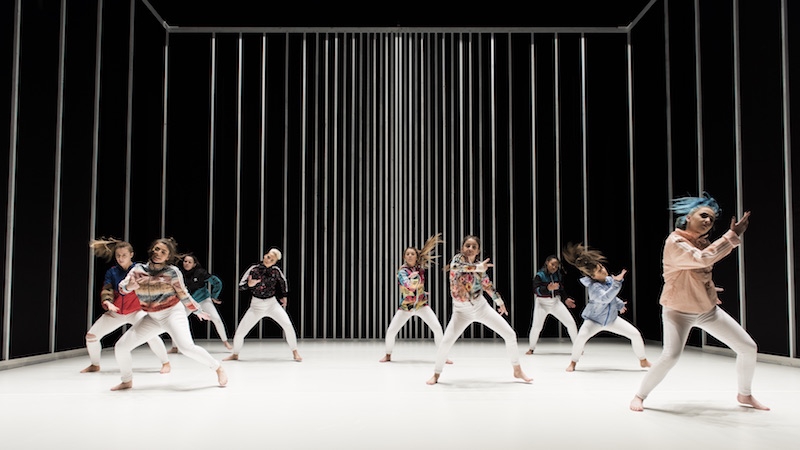To watch Oona Doherty dance is to witness something quite supernatural, like a crowd jostle and flicker through the body of a woman. Developed from her solo performance Hope Hunt & The Ascension into Lazarus (2016), which explored the gestures and postures of juvenile masculinity across European cultures, Hard to Be Soft: A Belfast Prayer (2017) locates the study within working-class communities in the city that has been the choreographer’s home since adolescence. With a punk sensibility, Doherty combines the ‘instinctive performance’ techniques of Guilherme Miotto and the dance theatre of Emma Martin (appearing, under Martin’s instruction, in Enda Walsh’s play Arlington in 2017) to create a uniquely visceral choreography.
In the first and last of the work’s four episodes, Doherty dances solo. In the second, Sugar Army, a troupe of ten young female hip-hop dancers dressed in shellsuits flow in and out of circles. Their line snakes and fragments to include and exclude individuals, expressing various formations of power among women. It recalls the forceful female energy that surrounded Doherty in the Belfast of her teens and the release from the pressures of the civil war (‘the Troubles’) that she and other young women found in competitive group dance. In the third episode, Meat Kaleidoscope, appears a pair of topless overweight white men, shuffling exaggeratedly slowly across stage towards one another until their abdomens touch, their fleshy trunks leaning in, arms folding across one another in a scene of macho sparring protracted into something more unfamiliar and trusting. There’s a question here of whether this symbolises a citywide resolution between Catholics and Protestants or a closer, more familial reconciliation: few homes were left unscathed by the war. Behind the men, their image in kaleidoscope is projected onto a minimal cubic set designed by Ciaran Bagnall, its walls of vertical slats angled and lit to resemble, at interludes, church or prison: disciplinary institutions that loomed large over these communities.
Northern Irish musician David Holmes has scored the piece with an oneiric combination of Renaissance choral music, electronica, street sounds and intermittent vocals recorded in Belfast. These vocals are carefully sampled so that while accent and intonation are clear, the details of what is being said are not, their volume and pitch intensifying during Doherty’s solos. In the first, Lazarus and the Bird of Paradise, her body channels these voices with a disconcerting precision of posture and gait. With slicked-back hair and wearing a plain, loose-fitting white t-shirt and sweatpants, she slips between men young and old; alone or in gangs; in bars or on streets; men against men and men among women; women in grief. Gregorio Allegri’s Miserere Mei (1630s) plays during her transitions and Doherty slips in and out of balletic movement to become a reclining Lazarus, spotlit from above as in a classical Renaissance composition. In the final section, Helium, Doherty continues her exploration of Lazarus and his resurrection, relearning movement in his reborn body. Scenes of this city’s people again flash before us, through her. A ‘dance prayer’, she has called it, for Belfast.
Oona Doherty is the featured artist of Dance Umbrella, which runs from 8 to 27 October across London. Hard to be Soft was performed at the Southbank Centre on 11 October.
